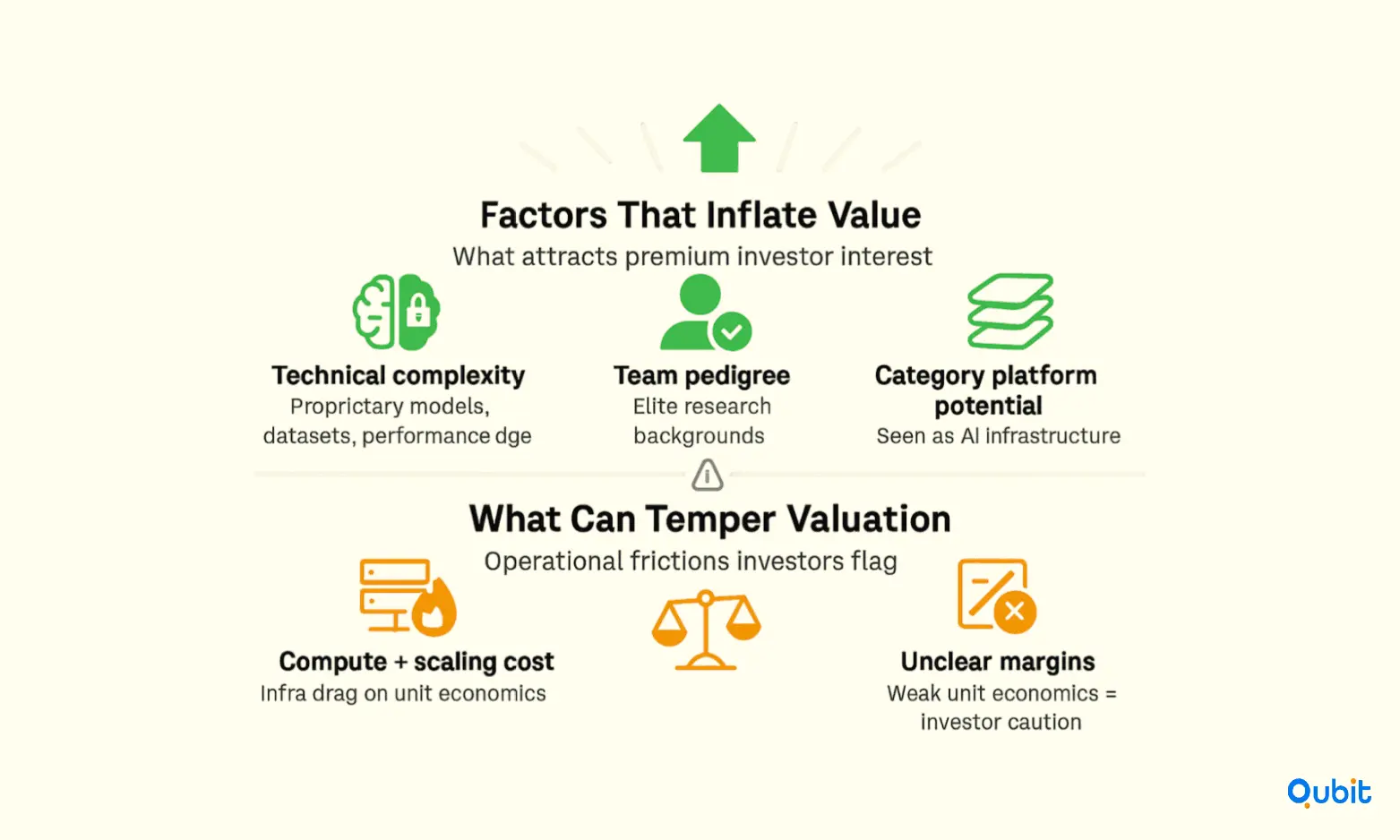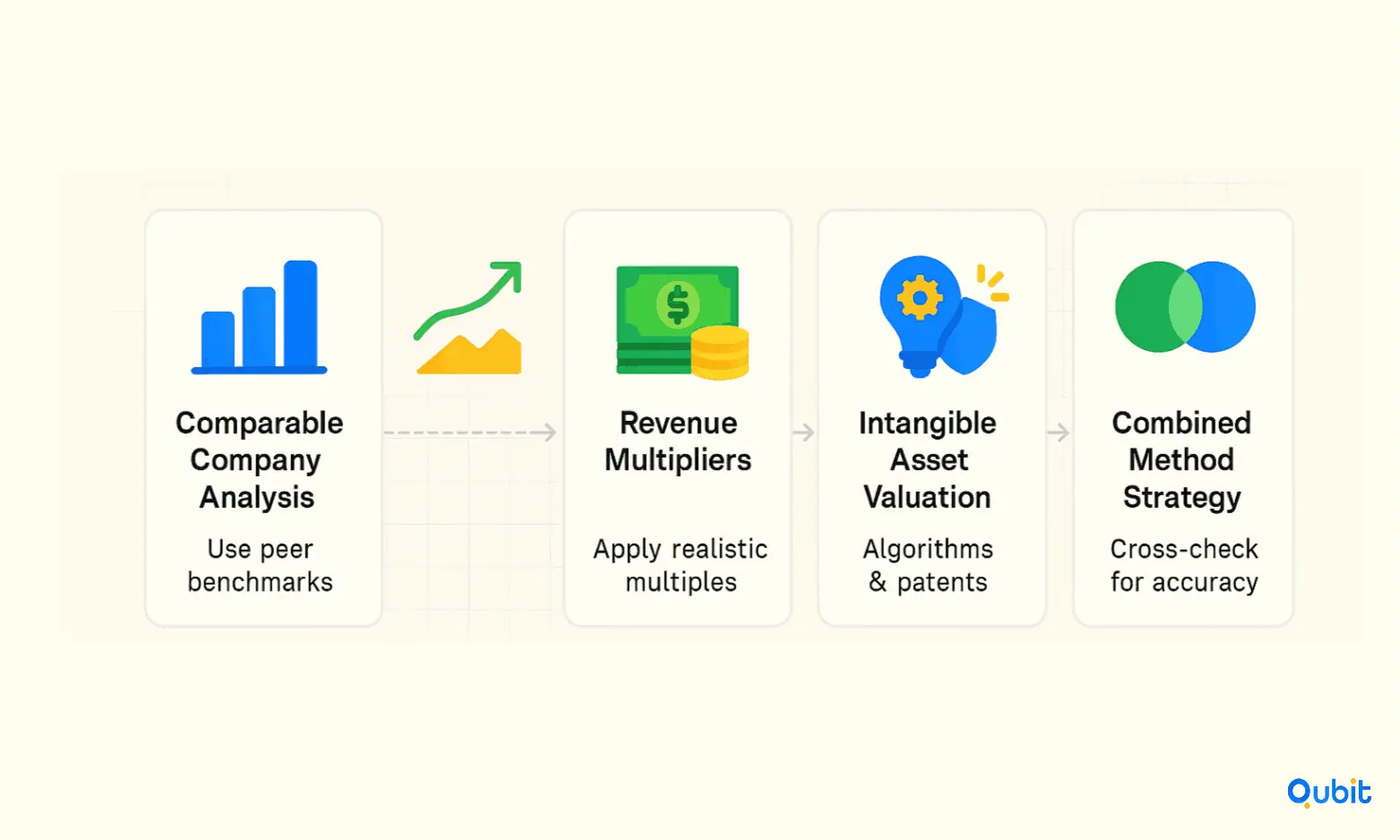Securing funding for an AI startup is a high-stakes process, where valuation and equity negotiations play a pivotal role. Striking the right balance between attracting investors and retaining control can be challenging, especially in a market driven by inflated expectations. For instance, understanding how equity is distributed, such as owning 15% of a company with 10,000 issued stocks, can clarify the stakes involved in these discussions.
This article will explore actionable strategies and valuation techniques tailored for AI startups. From addressing market hype to ensuring fair equity distribution, we’ll equip you with data-driven methods to negotiate effectively. For a broader perspective, check out how to raise money for AI startup, which situates your negotiation efforts within a wider context of fundraising strategies. Let’s jump right in.
Understanding the AI Valuation Dynamics
AI startups are not valued like typical SaaS or consumer tech companies. While traditional metrics, such as revenue multiples or user growth, still matter, additional factors are often in play:

- Technical Complexity: Proprietary models, differentiated algorithms, and access to unique datasets can command significant premiums, especially when combined with evidence of model performance.
- Team Credentials: A founding team with globally recognized AI talent or serious research pedigree can boost valuation well beyond what current revenue might suggest.
- Market Potential: Investors are keen to back category-defining, platform-level AI businesses, those seen as “picks and shovels” for the AI age.
- Compute and Scaling Costs: High infrastructure needs and future scaling challenges can temper valuations, especially if gross margins or unit economics remain unclear.
Startup Equity Fundamentals and Overview
Startup equity is the backbone of ownership distribution, shaping the dynamics of decision-making, founder stakes, and investor involvement. It represents a share in the company, offering stakeholders a slice of the potential future success. For founders, equity is not just a financial asset, it’s a tool to attract talent, secure funding, and align long-term goals with early contributors. However, understanding its nuances is critical to avoid pitfalls that can hinder growth.
Ownership Distribution: The Foundation of Equity
Ownership distribution determines who holds the reins of a startup. Founders typically begin with 100% ownership, but as the company grows, equity is allocated to co-founders, employees, and investors. This distribution impacts decision-making authority, voting rights, and the overall direction of the business. For instance, offering equity to early employees can incentivize them to contribute to the company’s success, while investors often require a significant stake in exchange for funding.
However, equity allocation must be approached strategically. Over-distribution can dilute founder control, while under-distribution may fail to attract the right talent or investment. Striking the right balance ensures that all stakeholders remain motivated without compromising the company’s vision.
Dilution Risks in the Age of AI Hype
The rise of artificial intelligence has fueled unprecedented excitement in the startup ecosystem. While this enthusiasm has led to soaring valuations, it also brings the risk of equity dilution. When startups raise funds at inflated valuations, they often issue additional shares to new investors. This process reduces the percentage of ownership held by existing stakeholders, including founders and early employees.
For example, if a startup initially valued at $10 million raises funds at a $50 million valuation, the founders may need to issue a larger portion of equity to secure the investment. While this may seem like a win, it can backfire if the valuation proves unsustainable, leaving founders with diminished stakes and limited control.
To mitigate these risks, startups must carefully evaluate their funding needs and avoid overvaluing their businesses. A realistic approach to valuation not only preserves equity but also builds trust with investors.
The Importance of Structured Equity Arrangements
Structured equity arrangements are essential for maintaining fairness and fostering growth. These arrangements outline how equity is distributed, vested, and managed over time. Vesting schedules, for instance, ensure that equity is earned gradually, preventing early contributors from leaving with significant stakes before delivering value.
Additionally, clear agreements can prevent disputes among co-founders and investors. For example, a well-drafted shareholder agreement can define voting rights, exit strategies, and the process for issuing new shares. This clarity protects all parties and ensures that the company can adapt to future challenges without internal conflicts.
Startups that prioritize structured equity arrangements are better positioned to attract top talent and secure funding. More importantly, they create a foundation for sustainable growth, ensuring that equity remains a tool for progress rather than a source of contention.
Proven Methods for AI Startup Valuation
Valuing an AI startup requires a nuanced approach that balances tangible metrics with the unique characteristics of artificial intelligence technologies. Founders and investors alike must account for factors such as capital structure, growth rates, market dynamics, and intangible assets like proprietary technology or intellectual property (IP). This section explores proven methodologies tailored specifically for AI startups, offering insights into how to cross-verify estimates and mitigate risks tied to hype-driven overvaluation.

1. Comparable Company Analysis (CCA)
One of the most straightforward methods for AI startup valuation is comparing the startup to similar companies in the industry. This approach uses valuation ratios, such as price-to-revenue or price-to-user metrics, derived from precedent transactions or publicly traded companies. For instance, companies like SendGrid and Mailerlite serve as examples of how revenue and user base metrics can be applied to determine valuation benchmarks.
CCA is particularly useful for startups with limited financial history, as it provides a market-based perspective. However, founders must ensure the chosen comparables align closely with their business model, technology stack, and market positioning to avoid skewed results.
2. Discounted Cash Flow (DCF) Analysis
For AI startups with predictable revenue streams or long-term contracts, the Discounted Cash Flow (DCF) model offers a robust valuation framework. This method calculates the present value of future cash flows, adjusted for risk and time. While DCF is highly detailed, its accuracy hinges on realistic assumptions about growth rates, operational costs, and market conditions.
AI startups often face challenges in forecasting cash flows due to the evolving nature of their technology and market adoption rates. Combining DCF with other methods, such as Comparable Company Analysis, can help cross-verify projections and reduce the risk of overvaluation.
3. Revenue-Based Multipliers
Revenue-based multipliers are another popular tool for valuing AI startups, especially those in early growth stages. This method applies industry-specific multiples to the startup’s revenue to estimate its worth. For AI companies, these multipliers often reflect the premium associated with cutting-edge technology and scalability potential.
However, founders should exercise caution when using revenue-based multipliers, as they can be influenced by market hype. To ensure accuracy, it’s essential to benchmark against realistic industry standards and historical precedent transactions.
4. Intangible Asset Valuation
AI startups often derive significant value from intangible assets, such as proprietary algorithms, machine learning models, and patents. Valuing these assets requires specialized techniques, such as cost-based or market-based approaches. For example, the cost-based method estimates the value of an asset by calculating the expenses incurred in its development, while the market-based approach compares it to similar assets sold in the market.
Given the importance of intangible assets in AI startups, founders should prioritize documenting and protecting their intellectual property. This not only enhances valuation but also strengthens the startup’s competitive edge.
5. Combining Multiple Methods
Relying on a single valuation method can lead to inaccuracies, especially in the dynamic AI sector. Combining techniques like DCF, Comparable Company Analysis, and revenue-based multipliers allows founders to cross-verify estimates and mitigate risks tied to hype-driven overvaluation.
For a deeper dive into valuation metrics, explore AI startup valuation multiples 2025, which offers quantitative insights that complement the methodologies discussed here.
Mitigating Risks in AI Startup Valuation
Valuation risks often stem from overestimating growth potential or underestimating operational challenges. To mitigate these risks, founders should:
- Conduct thorough market research to validate assumptions.
- Use conservative estimates for growth rates and revenue projections.
- Regularly update valuation models to reflect changing market dynamics.
By adopting a balanced approach, founders can ensure their valuations are both realistic and compelling to investors.
Key Steps to Negotiating Valuation and Equity
1. Benchmark Before You Bargain
Start by researching recent, comparable AI deals at your startup’s stage and geography. Use sources like Crunchbase, PitchBook, or reports from AI-focused VCs. Look for:
- Pre-seed/Seed: $3M–$12M post-money typical in 2024–2025, with some algorithmic/infra plays trending well above that.
- Series A: $15M–$60M post-money, heavily influenced by technical differentiation.
- Valuation-to-revenue or ARR multiples for AI can be 2–3× higher than for general SaaS, especially if there’s evidence of moat or early traction. To get a better understanding of look at the negotiation strategies and fundamentals.
2. Tell the Story of Your Technical and Data Moat
Demonstrate why your AI roadmap, data assets, or partnerships justify a higher multiple. Highlight:
- Proprietary datasets, partnerships with large enterprises, or unusual access to industry data
- Model benchmarks that outperform peers or open-source alternatives
- Revenue or cost-savings already attributed to AI-driven features (not just unproven promise)
The more tangible and defensible your technical edge, the more you can justify a better valuation.
3. Link Milestones to Valuation, Not Just Funding Needs
Investors want to see a credible plan for how new capital accelerates value creation. Instead of simply stating, "We’re raising $3M for 18 months of runway," tie the ask to specific milestones:
- What technical, GTM, or regulatory hurdles will you clear by the next round?
- How will these milestones de-risk the business and warrant further valuation step-ups?
- Can you support a higher valuation with early indications of product-market fit?
This approach projects discipline and helps maintain leverage in the negotiation.
4. Equity: Avoid Over-Dilution
Founders who give away too much equity early risk losing control (and motivation) later. As a rule of thumb:
- Pre-seed/Seed: Aim to sell 10–20% of the company per round (sometimes up to 25% in very early rounds, especially if capital needs are large)
- Series A: 15–25% is typical, with higher dilution justified only for transformative capital or top-tier lead investors
- Build in an equity pool (10–15%) for future key hires, which should be included in the pre-money valuation, not added on top after closing
- Be mindful: excessive dilution can make future rounds and retention problematic. Target 50–60% founder control after Series A, ideally higher.
5. Negotiate Terms Beyond Headline Valuation
Don’t focus solely on valuation; investor terms matter just as much:
- Liquidation Preferences: 1× non-participating is standard, but beware of anything more aggressive.
- Option Pool Shuffle: Clarify whether the option pool is created pre- or post-money; pre-money is more founder-friendly.
- Board Composition: Maintain founder/management influence; resist ceding majority control too early.
- Anti-Dilution Clauses: Ensure you understand, and negotiate, any full- or weighted-average clauses that might disadvantage you in future down-rounds.
6. Use Competition, But Don’t Overplay It
Having multiple term sheets is powerful, but don’t bluff or trigger a “winner’s curse.” Be transparent about real interest while respecting investor timelines. Use competing offers to negotiate terms up, not just raw valuation.
For those exploring broader fundraising strategies, the detailed analysis of valuation multiples in this guide creates a natural connection to the broader discussion on how to raise money for AI startup, situating financial insights within an expansive fundraising framework.
Common Mistakes and Red Flags
- Accepting the First Offer: Don’t jump at the first term sheet unless it’s truly founder-friendly. Always run a quick market check.
- Over-Optimism on Revenue: AI startups often overstate short-term revenue growth. Be realistic—investors will discount projections they don’t trust.
- Ignoring Founder Vesting or Option Pool Details: These “hidden” terms can hurt long-term outcomes more than headline valuation.
- Over-Diluting in Accelerators/Pre-Seed: Watch for stacked note rounds with large cumulative caps or heavy Safe/convertible dilution.
- Focusing Only on Money: Investor expertise, network, and strategic alignment are often worth more than a marginally higher valuation.
Conclusion
Securing fair investment deals and negotiating equity effectively requires a blend of strategic planning and clear communication. Throughout this blog, we explored key valuation techniques and negotiation strategies that empower startups to present their financial narrative with confidence. From understanding market trends to crafting a compelling story, these approaches ensure that founders can advocate for their business's true worth.
A narrative-driven approach not only strengthens your position but also builds trust with investors, fostering long-term partnerships. By applying these insights, startups can achieve equitable agreements that support sustainable growth.
If you're ready to refine your fundraising strategy with improved valuation and equity negotiation, we at Qubit Capital are here to help. Contact us to elevate your startup's financial narrative and secure the investment your business deserves.
Key Takeaways
- Clear equity structuring safeguards future growth and prevents excessive dilution.
- A combination of valuation methods provides a balanced approach to pricing a startup.
- Negotiation strategies must account for AI-specific market hype and realistic financial metrics.
- Expert advice and backup funding alternatives strengthen negotiation positions.
- Real-world examples and industry trends are key to informed and successful funding decisions.
Frequently asked Questions
How do you value an AI startup?
Valuing an AI startup involves applying methodologies such as Discounted Cash Flow (DCF), comparable analysis, and revenue multipliers. Additionally, factors like intellectual property, market dynamics, and the scalability of AI solutions play a significant role in determining the valuation.


 Back
Back



